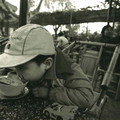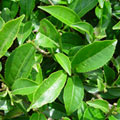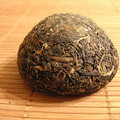Learning how to identify gu shu & make maocha - The Tea Urchin
„Mr. Gao pointed out some caterpillars that were fattening themselves on tea leaves. “No pesticides used here.”“
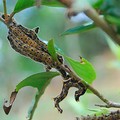
Quotes Tags: Pu-erh, Gushu, Tea production
„Mr. Gao showed us how to identify gu shu (ancient tree) tea leaves by looking at their texture, rubbing them between your fingers, and eating them raw. Old tea trees produce thicker, more leathery leaves that don’t easily come apart when you rub them. And gu shu buds should be white & shiny. When you chew them, the flavor is very bitter but there is also a strong sweet fragrance, and the juice is relatively easy to swallow. Tai di cha (terrace plantation tea) is also bitter but with a strong, lasting astringency on the sides & front of the tongue, and the juice is harder to swallow.“

Quotes Tags: Pu-erh, Gushu, Tea production, Experiencing tea
„When examining maocha, the colour of gu shu leaves tend to be more highly contrasted with a bright white hairy bud/tip surrounded by a grey, open leaf wrapper, with dark black stem & leaves. By comparison, tai di cha is almost all black, due to the use of fertilizer, the leaves grow quickly and the buds have less white hairs.“

Quotes Tags: Pu-erh, Gushu, Tea production
„I had heard from other puer buyers that Ma Hei farmers now use pesticide & fertilizer to boost yields. But as we stood there critiquing this batch of Ma Hei tea, a large, multi coloured beetle crawled out of the leaf pile. “We call this guy the tea boss” Mr. Gao explained. “If he’s around, it’s a good sign!”“
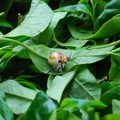
Quotes Tags: Pu-erh, Gushu, Tea production
„The terms "Xiao shu" (small tree) and "tai di" (terrace plantation) are often interchangeably used, but they should be given separate meanings. "Tai di" connotes high intensity farming, with the entire slope cleared & terraced to plant hedgerows & use of pesticide & fertilizer. But in many gu shu growing villages, there are also new tea plantations which are too young to be called gu shu (ie. less than 100 years old), but they aren't exactly "tai di" either. Many of these plants are growing next to old trees, in a bio-diverse forest clearing, with lots of space around them, not all are sprayed & fertilized. In the future, they will grow into "gu shu", until then we should call them "shen tai xiao shu" (naturally grown small trees)“
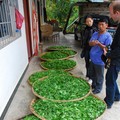
Quotes Tags: Pu-erh, Gushu, Tea production
„There is also a lack of formal definition for "gu shu." Some say "gu shu" should only refer to trees over 300 years of age, that is left to grow tall, and not pruned back. But in reality, most "gu shu" trees are cultivated, which entails annual pruning to encourage regrowth & lower branches for easy picking. A lot of "gu shu" on the market comes from trees as young as 100 years old, some of which is as short as 1.5m high. But a 100 year old tea tree growing in the wild can also grow higher than 3m high. Eventually the government will legislate what classifies as "gu shu." Until then, let the buyer beware!“

Quotes Tags: Pu-erh, Gushu, Tea production
Theme
Tea by region
We will help you with tea selection.
Do you like quality loose tea?
We will help you to find the right one for you. Be inspired by tea ratings of other tea lovers. Rating stars could help you.


Review your cup of tea.
Review the tea you are drinking and help other tea lovers to find the right cup of tea.



Teas
Shu 7581 - 2002
 1 review
1 review„tailor-made” private production “Zhong Cha Gong Si” This tea was stored for the whole time in...
Darjeeling Thurbo Wonder Delight Second Flush
 1 review
1 reviewThe best type of clonal tea, which was possible to taste this year. A wonderful, spicy, attractive and...
2015 Chawangpu Bada Lao Yu Xiao Bing
 1 review
1 reviewLao Yu (老妪) : old woman Material for this cake came from a small Bulang village in Bada...
Quotes
„Pang xie jiao; 旁鞋脚. Latin; (Viscum articulatum Burm.f.) Literally Crabs legs. A parasitic plant that grows on trees in sub-tropical regions. When it grows on the tea tree it absorbs flavour from the tree and makes a sweet, refreshing drink, hot or cool. Very limited availability. Puer cakes can be found that have Pangxiejiao mixed into the cake. Normally around 10-15%. It is also part of the Chinese medicine pharmacopoeia – said to have a diuretic effect and is used to clear heat“



 Shops
Shops Share on Facebook
Share on Facebook



